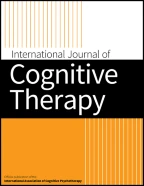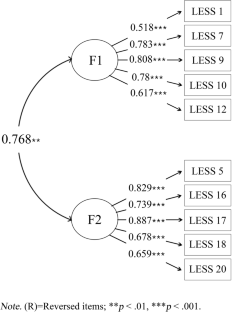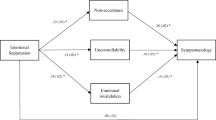A Brief Version of the Leahy Emotional Schema Scale: a Validation Study

The Leahy Emotional Schema Scale II (LESS II) was developed based on the emotional schema model, a meta-experiential model targeting emotion and emotion regulation (Leahy 2012). This model is important for identifying individuals’ negative beliefs about emotions as well as for dealing with noncompliance, resistance, and drop-outs in cognitive behavioral therapy. The primary aim of the current study was to explore the factor structures of the previously validated LESS II, and investigate its reliability and validity within a Korean sample. The secondary aim of this study was to examine how emotional schema would be associated with the emotional distress and behavioral problems of Korean college students. A total of 1478 college students participated in the current study and were administered questionnaires including the Leahy Emotional Schema Scale II, Counseling Center Assessment of Psychological Symptoms (CCAPS), and College Adjustments Inventory-Short Form (CAIS). A series of statistical analyses resulted in the deletion of several items and emotional schema dimensions from the LESS II, owing to methodological and cultural reasons. The final results showed that the two-factor model with 10 items was the model with the better fit than was the original 14-factor structure model with 28 items. The total score of the 10-item LESS II showed great convergent validity, with moderate to strong positive correlations with CCAPS subscales. Furthermore, the 10-item LESS II demonstrated high internal consistency and shared approximately 87.05% of variance with the original 28-item LESS II. The findings of the current study provide strong support for the clinical and research application of the 10-item LESS II.
This is a preview of subscription content, log in via an institution to check access.
Access this article
Subscribe and save
Springer+ Basic
€32.70 /Month
- Get 10 units per month
- Download Article/Chapter or eBook
- 1 Unit = 1 Article or 1 Chapter
- Cancel anytime
Buy Now
Price includes VAT (France)
Instant access to the full article PDF.
Rent this article via DeepDyve


Similar content being viewed by others

Rethinking Leahy’s Emotional Schema Scale (LESS): Results from the Portuguese Adaptation of the LESS
Article 26 April 2022
Interpersonal Emotion Regulation Questionnaire (IERQ): Scale Development and Psychometric Characteristics
Article 30 January 2016

Emotional schemas mediate the relationship between emotion regulation and symptomatology
Article 20 March 2021
References
- American Psychiatric Association. (2000). Diagnostic and statistical manual of mental disorders: DSM-IV-TR. Washington, DC: American Psychiatric Association. Google Scholar
- Bagozzi, R., Wong, N., & Yi, Y. (1999). The role of culture and gender and the relationship between positive and negative affect. Cognit Emot, 3, 641–672. ArticleGoogle Scholar
- Batmaz, S., & Özdel, K. (2015). Psychometric properties of the Turkish version of the Leahy Emotional Schema Scale-II. Anatolian Journal of Psychiatry/Anadolu Psikiyatri Dergisi, 16(Supplement 1), 23–30. ArticleGoogle Scholar
- Beck, A. T., Steer, R. A., & Brown, G. K. (1996). Manual for the Beck Depression Inventory-II. San Antonio, TX: Psychological Corporation. Google Scholar
- Bond, F. W., Hayes, S. C., Baer, R. A., Carpenter, K. M., Guenole, N., Orcutt, H. K., . & Zettle, R. D. (2011). Preliminary psychometric properties of the Acceptance and Action Questionnaire–II: a revised measure of psychological inflexibility and experiential avoidance. Behav Ther, 42(4), 676–688.
- Brown, K. W., & Ryan, R. M. (2003). The benefits of being present: mindfulness and its role in psychological well-being. J Pers Soc Psychol, 84, 822–848. ArticlePubMedGoogle Scholar
- Butler, E. A., Egloff, B., Wilhelm, F. H., Smith, N. C., Erickson, E. A., & Gross, J. J. (2003). The social consequences of expressive suppression. Emotion, 3, 48–67. ArticlePubMedGoogle Scholar
- Butler, E. A., Lee, T. L., & Gross, J. J. (2007). Emotion regulation and culture: are the social consequences of emotion suppression culture-specific? Emotion, 7(1), 30. ArticlePubMedGoogle Scholar
- Choi, I., & Choi, Y. (2002). Culture and self-concept flexibility. Personal Soc Psychol Bull, 28, 1508–1517. ArticleGoogle Scholar
- Greenberg, L. S. (2004). Emotion–focused therapy. Clinical Psychology & Psychotherapy, 11(1), 3–16. ArticleGoogle Scholar
- Gross, J. J., & John, O. P. (2003). Individual differences in two emotion regulation processes: implications for affect, relationships, and wellbeing. J Pers Soc Psychol, 85, 348–362. ArticlePubMedGoogle Scholar
- Gross, J. J., & Thompson, R. A. (2007). Emotion regulation: conceptual foundations. In J. J. Gross (Ed.), Handbook of emotion regulation (pp. 3–24). New York, NY: Guilford Press. Google Scholar
- Hayes, S. C., Strosahl, K. D., & Wilson, K. G. (1999). Acceptance and commitment therapy: an experiential approach to behavior change. New York: Guilford Press. Google Scholar
- Henson, R. K. (2001). Understanding internal consistency reliability estimates: a conceptual primer on coefficient alpha. Meas Eval Couns Dev, 34, 177–189. ArticleGoogle Scholar
- Heywood, H. B. (1931). On finite sequences of real numbers. Proc R Soc Lond A, 134(824), 486–501. ArticleGoogle Scholar
- Issakidis, C., & Andrews, G. (2004). Pretreatment attrition and dropout in an outpatient clinic for anxiety disorders. Acta Psychiatr Scand, 109(6), 426–433. ArticlePubMedGoogle Scholar
- Kim, D. H., Pan, Y. G., & Park, H. S. (1998). High versus low context culture: a comparison of Chinese, Korean, and American cultures. Psychology & Marketing, 15(6), 507–521. ArticleGoogle Scholar
- Kim, Y. J., Sohn, D. Y., & Choi, S. M. (2011). Cultural difference in motivations for using social network sites: a comparative study of American and Korean college students. Comput Hum Behav, 27(1), 365–372. ArticleGoogle Scholar
- Kleinman, A. (1982). Neurasthenia and depression: A study of somatization and culture in China. Cult Med Psychiatry, 6(2), 117–190. ArticlePubMedGoogle Scholar
- Kline, R. B. (2011). Principles and practice of structural equation modeling (3rd ed.). New York, NY: The Guilford Press. Google Scholar
- Leahy, R. L. (2001). Depressive decision making: validation of the portfolio theory model. J Cogn Psychother, 15(4), 341. ArticleGoogle Scholar
- Leahy, R. L. (2002). A model of emotional schemas. Cogn Behav Pract, 9(3), 177–190. ArticleGoogle Scholar
- Leahy, R. L. (2007a). Emotional schemas and resistance to change in anxiety disorders. Cogn Behav Pract, 14(1), 36–45. ArticleGoogle Scholar
- Leahy, R. L. (2007b). Emotional schemas and self-help: homework compliance and obsessive-compulsive disorder. Cogn Behav Pract, 14(3), 297–302. ArticleGoogle Scholar
- Leahy, R. L. (2012). Leahy Emotional Schema Scale II (LESS II). Unpublished manuscript, American Institute for Cognitive Therapy, New York.
- Leahy, R. L. (2016). Emotional schema therapy: a meta-experiential model. Aust Psychol, 51(2), 82–88. ArticleGoogle Scholar
- Leahy, R. L., & Wupperman, P. (2015). Emotion regulation and psychopathology: pathways, processes, and treatment. Unpublished manuscript, American Institute for Cognitive Therapy, New York.
- Leahy, R. L., Tirch, D. D., & Melwani, P. S. (2012). Processes underlying depression: risk aversion, emotional schemas, and psychological flexibility. International Journal of Cognitive Therapy, 5(4), 362–379. ArticleGoogle Scholar
- Lee, S. H. (1977). A study on the hwa-byung (anger syndrome). Journal of Korean General Hospital, 1, 63–69. Google Scholar
- Lee, K. A., Shin, H. L., Yoo, N. H., & Lee, K. H. (2008). The development and validation of the college adjustment inventory-short form. The Korea Journal of Counseling, 9(2), 739–745. ArticleGoogle Scholar
- Lee, S., Kim, J., Choi, S., Chae, J., Choi, Y., Seo, D. G., & Kwon, H. (2017). New directions for depression studies: Introduction of behavioral science approach. The Korean Journal of Psychology: General, 36(3), 293–323. Google Scholar
- Lin, K. M., & Cheung, F. (1999). Mental health issues for Asian Americans. Psychiatr Serv, 50(6), 774–780. ArticlePubMedGoogle Scholar
- Linehan, M. M. (1993). Cognitive-behavioral treatment of borderline personality disorder. New York: Guilford Press. Google Scholar
- Locke, B. D., McAleavey, A. A., Zhao, Y., Lei, P. W., Hayes, J. A., Castonguay, L. G., et al. (2012). Development and initial validation of the counseling center assessment of psychological symptoms–34. Meas Eval Couns Dev, 45(3), 151–169. ArticleGoogle Scholar
- Okazaki, S. (1997). Sources of ethnic differences between Asian American and White American college students on measures of depression and social anxiety. J Abnorm Psychol, 106, 52–60. ArticlePubMedGoogle Scholar
- Park, Y. J., Kim, H. S., Schwartz-Barcott, D., & Kim, J. W. (2002). The conceptual structure of hwa-byung in middle-aged Korean women. Health Care for Women International, 23(4), 389–397. ArticlePubMedGoogle Scholar
- Park, H., Rehg, M. T., & Lee, D. (2005). The influence of Confucian ethics and collectivism on whistle blowing intentions: a study of South Korean public employees. J Bus Ethics, 58(4), 387–403. ArticleGoogle Scholar
- Peng, K., & Nisbett, R. E. (1999). Culture, dialectics, and reasoning about contradiction. Am Psychol, 54, 741–754. ArticleGoogle Scholar
- Schimmack, U., Oishi, S., & Diener, E. (2002). Cultural influences on the relation between pleasant emotions and unpleasant emotions: Asian dialectic philosophies or individualism-collectivism? Cognit Emot, 16, 705–719. ArticleGoogle Scholar
- Segal, Z. V., Williams, J. M. G., & Teasdale, J. D. (2002). Mindfulness-based cognitive therapy for depression: a new approach to preventing relapse. New York: Guilford Press. Google Scholar
- Silberstein, L. R., Tirch, D., Leahy, R. L., & McGinn, L. (2012). Mindfulness, psychological flexibility, and emotional schemas. International Journal of Cognitive Therapy, 5(4), 406–419. ArticleGoogle Scholar
- Souery, D., Oswald, P., Massat, I., Bailer, U., Bollen, J., Demyttenaere, K., et al. (2007). Clinical factors associated with treatment resistance in major depressive disorder: results from a European multicenter study. J Clin Psychiatry, 68(7), 1062–1070. ArticlePubMedGoogle Scholar
- Spencer-Rodgers, J., Peng, K., Wang, L., & Hou, Y. (2004). Dialectical self-esteem and east-west differences in psychological well-being. Personal Soc Psychol Bull, 30, 1416–1432. ArticleGoogle Scholar
- Sue, D. W., & Kirk, B. A. (1975). Asian-Americans: use of counseling and psychiatric services on a college campus. J Couns Psychol, 22, 84–86. ArticleGoogle Scholar
- Tirch, D. D., Leahy, R. L., Silberstein, L. R., & Melwani, P. S. (2012). Emotional schemas, psychological flexibility, and anxiety: the role of flexible response patterns to anxious arousal. International Journal of Cognitive Therapy, 5(4), 380–391. ArticleGoogle Scholar
- Tracey, T., Leong, F., & Glidden, C. (1986). Help seeking and problem perception among Asian Americans. J Couns Psychol, 33, 331–336. ArticleGoogle Scholar
- Wenze, S. J., Goldberg, J. F., Singer, T. M., Endick, C. J., & Leahy, R. L. (2003, TBA). Longitudinal assessment of emotional schemas in bipolar outpatients. Paper presented at the American Psychiatric Association, San Francisco.
- Yavuz, K. F., Türkçapar, M. H., Demirel, B., & Karadere, E. (2011). Adaptation, validity and reliability of the Leahy Emotional Schema Scale Turkish version based on Turkish university students and workers. Dusunen Adam, 24(4), 273. ArticleGoogle Scholar
Funding
This work was supported by the Ministry of Education of the Republic of the Korea and National Research Foundation of Korea (NRF-2017S1A5B6053101), the General Collaborative Research Project (2018S1A5A2A03030006), and the MSIT (Ministry of Science and ICT), Korea, under the ITRC (Information Technology Research Center) support program (IITP-2018-0-01405) supervised by the IITP (Institute for Information & communications Technology Promotion).
Author information
- Department of Psychology, Korea University, 145 Anam-ro, Anam-dong, Seongbuk-gu, Seoul, South Korea Jong-Woo Suh & Kee-Hong Choi
- Department of Psychology, Hallym University, 1, Hallymdaehak-gil, Chuncheon-si, Gangwon-do, 24252, South Korea Heejae J. Lee & Dong Gi Seo
- Department of Psychology, Kyungsung University, Busan, South Korea Nahyun Yoo
- Sol Liberal Arts School, Woosong University, Daejeon, South Korea Han Min
- Jong-Woo Suh





